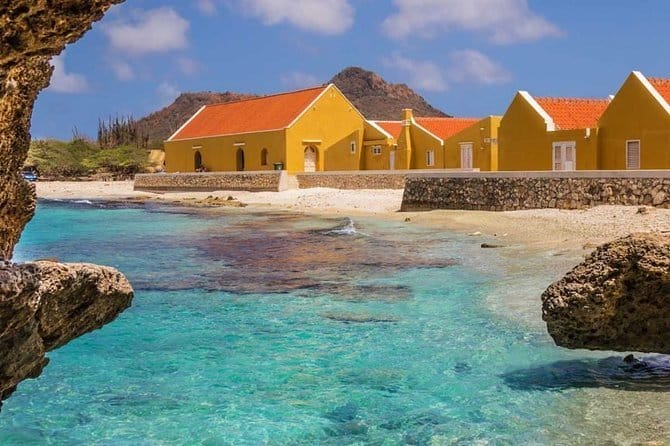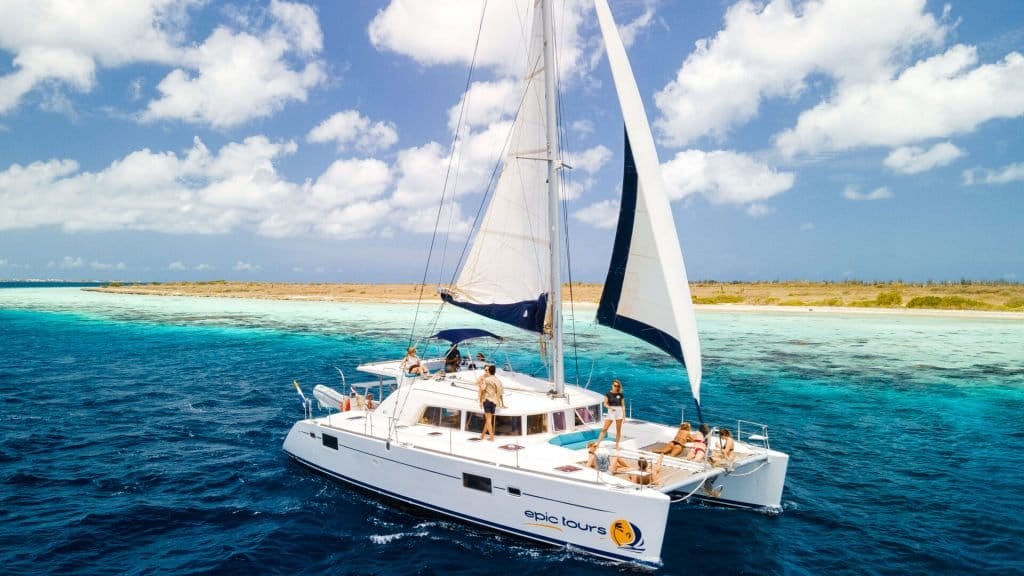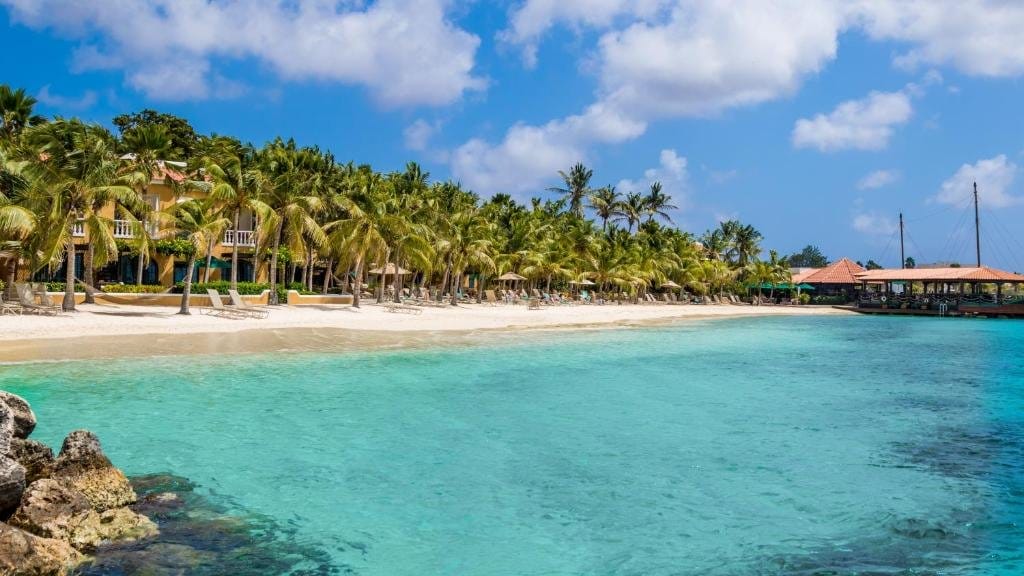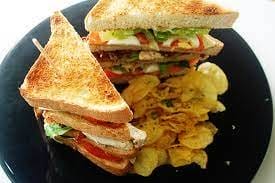Your Next Trip TRAVEL GUIDE
Bonaire
Bonaire, part of the Dutch Caribbean’s ABC islands, offers a unique blend of history, nature, and adventure. Located outside the hurricane belt, it’s a year-round destination with a desert landscape, iconic salt flats, and a rich colonial history tied to salt production. Explore Washington Slagbaai National Park, a pioneer in nature preservation, or dive into the island’s pristine underwater environments, perfect for snorkeling and scuba diving. For thrill-seekers, Bonaire’s trade winds create ideal conditions for windsurfing, and landsailing provides an exciting alternative for land-based adventure. This island is a true gem, with something for every type of traveler.
Now, check out our recommendations featured in this episode and more!







What to do
Washington Slagbaai National Park
Bonaire’s first nature sanctuary, this park spans over 23 square miles of protected land. Explore hidden beaches, go snorkeling, and spot the island’s wildlife. The park is a must-visit for nature lovers, offering a glimpse into the island’s rich biodiversity.
Address: Washington Slagbaai National Park, Bonaire
Hours: Daily, 8:00 a.m. – 5:00 p.m.
Cost: $40 STINAPA Nature Fee (required for water activities and park access)
Website: STINAPA Bonaire
1000 Steps Beach
Famous for its scenic views and coral-laden shore, this beach is one of the most iconic spots on the island. Despite its name, it’s only 67 steps down to reach the beach. It’s a prime location for snorkeling and diving.
Address: Queen’s Highway, Bonaire
Hours: Open 24 hours
Cost: Free
Cadushy Distillery
Located in the historic village of Rincon, this distillery offers tastings of Bonaire’s unique cactus liqueur and award-winning rum. It’s a great stop for those interested in learning about local beverages and culture.
Address: Kaya Cadushy 8, Rincon, Bonaire
Hours: Monday – Friday, 10:00 a.m. – 5:00 p.m.
Cost: Free (tasting packages available)
Website: Cadushy Distillery
Klein Bonaire Diving & Snorkeling
The uninhabited island of Klein Bonaire is a protected marine park known for its pristine coral reefs and crystal-clear waters. It’s a diver and snorkeler’s paradise, offering an up-close look at the rich underwater life Bonaire is famous for.
Address: Klein Bonaire
Hours: Daily tours depart in the morning
Cost: Varies by tour operator (around $45 for snorkel tours)
Website: Divi Flamingo Beach Resort
Windsurfing
Bonaire’s trade winds make it one of the best spots in the world for windsurfing. Jibe City offers lessons for beginners and equipment rentals for more experienced surfers. Relax on the beach or try your hand at this exhilarating sport.
Address: Sorobon Beach, Bonaire
Hours: 8:00 a.m. – 6:00 p.m.
Cost: $35+ for windsurfing lessons
Website: Jibe City
Bonaire Landsailing Adventures
If you need a break from the water, try landsailing! This unique activity involves racing wind-powered carts around a sandy track. It’s fast, fun, and the perfect way to enjoy Bonaire’s windy conditions without getting wet.
Address: Kaminda Sorobon, Bonaire
Hours: Monday – Saturday, 9:00 a.m. – 5:00 p.m.
Cost: $45 for a 1-hour session
Website: Bonaire Landsailing
Epic Tours Chill & Grill Sunset Sail
Take a luxurious sunset sail along the coast of Bonaire with Epic Tours. The tour includes snorkeling, a guided exploration of the marine life, and a gourmet 4-course dinner on board a catamaran.
Address: Kaya C.E.B. Hellmund 17, Kralendijk, Bonaire
Hours: Departs daily at 2:30 p.m.
Cost: $115 per person
Website: Epic Tours Bonaire
Where to stay
Harbour Village Beach Club
This luxury resort offers spacious rooms, a private beach, and first-class amenities. Spend your leisure time relaxing by the pool or exploring the resort’s film room.
Address: Kaya Gobernador N. Debrot 71, Kralendijk, Bonaire
Cost: From $395 per night
Website: Harbour Village Beach Club
Divi Flamingo Beach Resort & Casino
A casual beachfront resort with excellent diving facilities and close proximity to the island’s main attractions. Ideal for both families and adventurers.
Address: J.A. Abraham Blvd 40, Kralendijk, Bonaire
Cost: From $175 per night
Website: Divi Flamingo Beach Resort
And there’s tons of other fabulous places to stay during your trip.
Check out the best accommodation deals below.






What to eat
Sebastian’s Restaurant
An oceanfront dining experience with Mediterranean flair and local influences, Sebastian’s is the perfect place to enjoy sunset views and a relaxed atmosphere.
Address: 12 EEG Boulevard, Kralendijk, Bonaire
Hours: Tuesday – Sunday, 5:00 p.m. – 10:00 p.m.
Cost: Entrées from $25
Website: Sebastian’s Restaurant
Posada Para Mira
For an authentic taste of Bonaire, head to this countryside restaurant offering local favorites like goat stew and fried plantains. For the more adventurous, try the iguana soup!
Address: Kaya Para Mira 9, Rincon, Bonaire
Hours: Wednesday – Sunday, 11:30 a.m. – 5:00 p.m.
Cost: Entrées from $15
Website: Posada Para Mira
Ingridients Restaurant
Using locally sourced ingredients, this restaurant serves Mediterranean cuisine with a fresh, creative twist. The extensive wine list is a bonus!
Address: Kaya Gob. N. Debrot 85, Kralendijk, Bonaire
Hours: Thursday – Sunday, 6:00 p.m. – 10:00 p.m.
Cost: Entrées from $30
Website: Ingridients Restaurant
Boudoir Bonaire
A cozy tropical garden setting, Boudoir serves breakfast and lunch with a focus on fresh, organic ingredients.
Address: Kaya Grandi 34, Kralendijk, Bonaire
Hours: Monday – Saturday, 8:00 a.m. – 2:00 p.m.
Cost: Breakfast from $12, lunch from $15
Website: Boudoir Bonaire
Travel Tips
Best Time to Visit
Bonaire’s location outside the hurricane belt makes it a great year-round destination.
However, the best time to visit is during the dry season, from December to April, when the weather is mild and the risk of rain is low. This is also peak season, so book your accommodations early.
For a quieter experience, consider visiting between May and August, when the island is less crowded but still pleasant.Getting Around
Bonaire is a small island, making it easy to navigate.
Renting a car is the best option to explore at your own pace, especially if you plan to visit Washington Slagbaai National Park or go to more remote beaches like 1000 Steps.
Taxis are available but can be expensive for frequent use.
There is no public transportation system on Bonaire, and ride-sharing services like Uber are not available.
Many visitors opt for bicycles or scooters to explore Kralendijk and nearby areas.
Safety Tips
Bonaire is considered a very safe destination for travelers. However, as with any location, exercise common sense by securing your belongings and locking your car.
Be cautious when snorkeling or diving, especially in areas with strong currents. Always go with a buddy, and ensure you're equipped with a STINAPA nature tag for any water activities.
Wildlife, such as the island's flamingos, are protected. Always keep a respectful distance and avoid disturbing animals in their natural habitat.
Roads in more remote areas can be unpaved and rough, especially in the national park. Drive carefully and consider renting a 4x4 vehicle if you plan to explore these areas.Helpful Notes
Currency: The official currency is the US Dollar, making it convenient for American travelers. Credit cards are widely accepted, but it’s a good idea to carry some cash for smaller purchases and in more remote areas.
Language: While Dutch is the official language, Papiamento is widely spoken. English and Spanish are also commonly understood, especially in tourist areas.
Water: Bonaire has excellent tap water, which is safe to drink, as it comes from desalinated seawater.
Nature Fee: All visitors participating in water activities or visiting Washington Slagbaai National Park are required to pay the STINAPA nature fee. You can purchase this online or at designated spots on the island.
Driving: Bonaire follows European driving regulations, so you’ll be driving on the right side of the road. Seat belts are mandatory, and cell phone use while driving is prohibited.
Plug Type: Type A (two-pin) and Type B (three-pin, grounded)
Voltage: 127 V
Frequency: 50Hz

Packing list
Here’s our suggested items to pack for this destination. Please always consider the weather and activities you will be doing.
Clothing:
- Light, breathable clothing for the hot, dry climate (cotton and linen recommended)
- Swimsuits (bring a few for multiple beach and water activities)
- Rash guard or swim shirt for snorkeling and diving
- Casual evening wear for dinners
- Hat or visor for sun protection
- Light jacket or sweater for cooler evenings or boat trips
- Comfortable walking shoes or sandals
- Water shoes (helpful for rocky beaches like 1000 Steps)
Beach & Water Activities:
- Snorkeling gear (mask, snorkel, fins – though available for rent, bringing your own can be more comfortable)
- Quick-dry towel
- Waterproof phone case or dry bag for beach and water adventures
- Reef-safe sunscreen (essential for marine protection)
- Sunglasses with UV protection
Outdoor Adventure:
- Insect repellent
- Lightweight daypack for hiking or exploring
- Water bottle (stay hydrated while hiking and beach-hopping)
- Reusable shopping bag (handy for beach outings and eco-friendly)
Documents & Essentials:
- STINAPA Nature Fee receipt (for water activities and National Park)
- Valid ID or passport
- Driver’s license if you plan to rent a car
- Copies of important documents (travel insurance, reservations)
Other Important Items:
- Camera or GoPro for underwater photography
- Portable phone charger (especially useful during long day trips)
- Adapter for electronics
Get a full packing list and free downloadable template at Pack Better.
Ultimate Packing List Library
Find the perfect customizable packing list for all of your travel situations on our sister website Pack Better.
This episode of "Your Next Trip" explored the ancestral lands of
We extend our respect and gratitude to the Indigenous communities who have been the stewards of these lands for generations. Research for this acknowledgment was made possible using the NativeLand.ca.
Learn more about responsible travel practices in the TWD Responsible Travel Guide.
Visit the guideTrip provided by: Bonaire Tourism
Editor: Muhammad Arsalan
Special Thanks: Diamond PR





